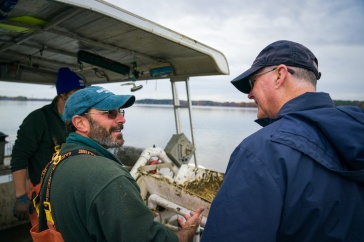
Up to 100,000 winter ticks can live on a moose, causing severe hair loss and reduced reproductive productivity. Photo courtesy Daniel Bergeron
In New Hampshire, the mighty moose – the shy, stately, 750-pound beast that drives tourism in the North Country – is on the decline. Its current population, estimated at 4,400 animals, has dropped from the 1996 high of 7,600. But the primary threat to the moose isn’t bullets, bumpers, or even teeth: scientists think warmer winters are to blame, although not how you might think.
“I think it’s very unreasonable to think that distress due to heat is causing this decline in the moose population,” says UNH professor of wildlife biology Pete Pekins. “We think it’s probably a combination of parasites and diseases.”
Pekins, in partnership with N.H. Fish and Game, is leading a new study that will track up to 100 calves and adult female moose over the next two years to learn why there are fewer of them. It’s work with serious financial implications: Wildlife-watchers in New Hampshire, most of whom come for a glimpse of the iconic moose, spend an estimated $250 million annually, and sales of moose hunting permits generate another $325,000.
|
At a check station in Berlin several years ago, students Stacy Eastman ’10 and Wes Smith ’10, ’13G counted winter ticks on moose brought in by hunters. Photo courtesy Pete Pekins. |
In the researchers’ crosshairs is the winter tick -- a single-host parasite that lives on members of the deer family – which is thriving as winters in New Hampshire are shrinking. Although tiny, the tick, Dermacentor albipictus, finds strength in numbers when infesting moose. A single moose can host up to 120,000 of the blood-suckers, resulting in anemia and blood and hair loss. A previous study led by Pekins concluded that the winter tick had a major impact on moose population.
“There’s no question that these things can kill calves and debilitate yearling moose such that their productivity is probably reduced,” he says.
Climate change has made the environment friendlier to these parasites. Specifically, snow – its depth and the amount of time it covers the ground – plays a key role in the increase of winter ticks. As New Hampshire’s snow cover arrives later and recedes earlier, Pekins says, ticks proliferate.
Pekins and collaborators are also interested in the impact of brainworm, which is carried by (but not harmful to) deer and fatal to moose. Deer population is on the rise, also perhaps due to milder winters. “A lot of little things are operating, and many of these are enhanced by shorter winters,” Pekins says. “The irony is that what we might call a hard winter in northern New Hampshire is an easy winter for a moose.”
With a grant of nearly $700,000 from the federal government, the researchers will capture and radio-collar approximately 20 calves and 20 adult cow moose this December and next. Working in the moose-rich Androscoggin River Valley north of Berlin, they’ll examine the moose upon capture, then observe their health as they progress through pregnancy and calving.
“Deaths occur all the time in the wild, and nobody sees it. When you have marked animals, you can follow them to see their fate,” Pekins says. Collaring the animals represents “a huge part of the cost of the project,” he adds, but a necessary one. “You couldn’t catch so many animals so quickly if you went along the roadsides.”
In addition, many wildlife undergraduate and graduate students took to the state’s check stations recently, during the first weekend of moose hunting season, to count ticks on moose that had been shot.
Pekins has been studying moose, in partnership with N.H. Fish and Game biologists (many of whom were his former students), for more than a decade, making UNH a leader in moose research nationally. While Maine boasts more moose than in the rest of the 48 contiguous U.S. states combined, New Hampshire is at the southern end of the beast’s range, making Granite State moose something of a canary in the climate change coalmine.
“New Hampshire has been the catalyst for moose research in New England for 30 years,” Pekins says, noting that Maine will now launch a sister study simultaneously (led by Lee Kantar ‘95, a former student of his), and Minnesota launched a major study in January. “This probably represents the biggest simultaneous effort ever in moose research, and here’s little old New Hampshire as a major player.”
-
Written By:
Staff writer | Communications and Public Affairs





















































